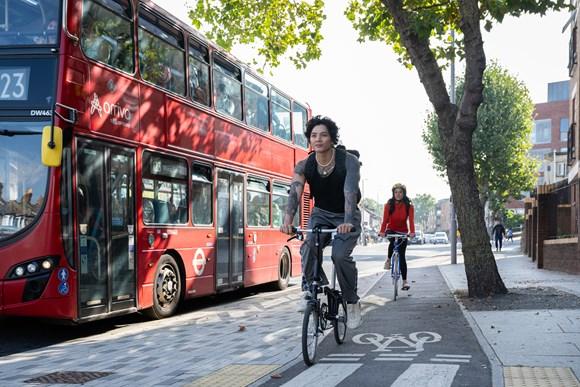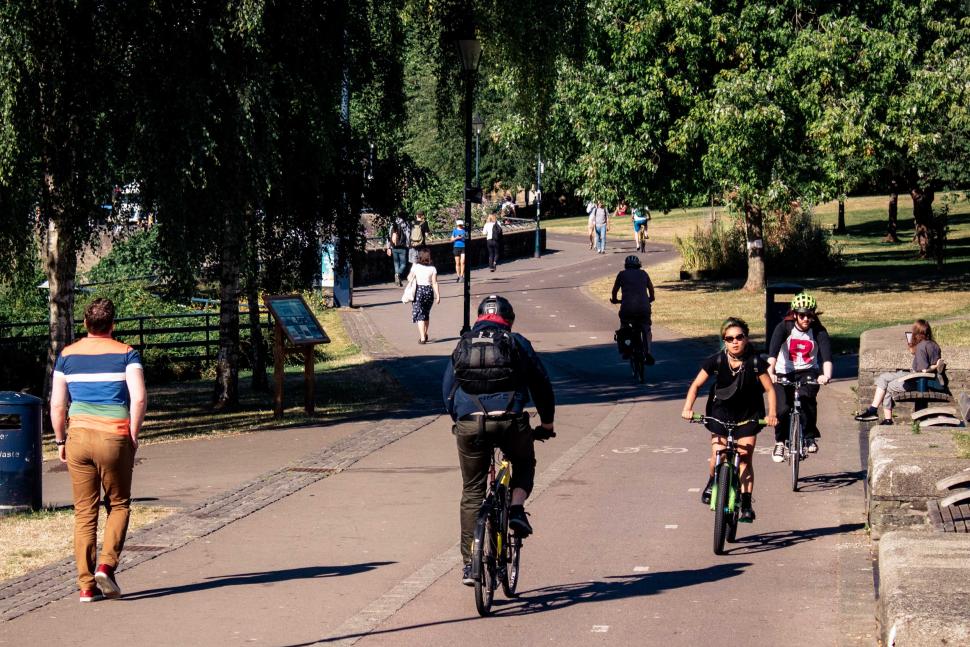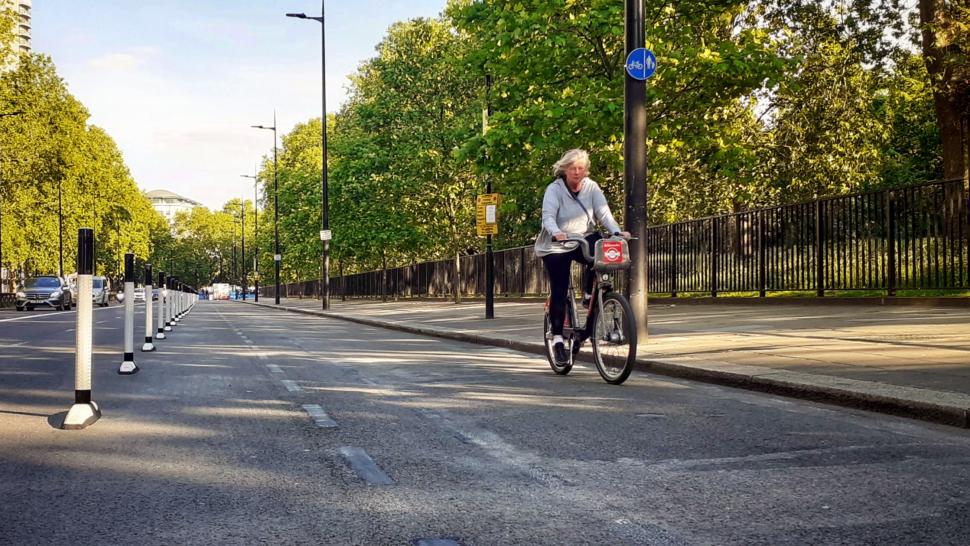- News
- Reviews
- Bikes
- Components
- Bar tape & grips
- Bottom brackets
- Brake & gear cables
- Brake & STI levers
- Brake pads & spares
- Brakes
- Cassettes & freewheels
- Chains
- Chainsets & chainrings
- Derailleurs - front
- Derailleurs - rear
- Forks
- Gear levers & shifters
- Groupsets
- Handlebars & extensions
- Headsets
- Hubs
- Inner tubes
- Pedals
- Quick releases & skewers
- Saddles
- Seatposts
- Stems
- Wheels
- Tyres
- Tubeless valves
- Accessories
- Accessories - misc
- Computer mounts
- Bags
- Bar ends
- Bike bags & cases
- Bottle cages
- Bottles
- Cameras
- Car racks
- Child seats
- Computers
- Glasses
- GPS units
- Helmets
- Lights - front
- Lights - rear
- Lights - sets
- Locks
- Mirrors
- Mudguards
- Racks
- Pumps & CO2 inflators
- Puncture kits
- Reflectives
- Smart watches
- Stands and racks
- Trailers
- Clothing
- Health, fitness and nutrition
- Tools and workshop
- Miscellaneous
- Buyers Guides
- Features
- Forum
- Recommends
- Podcast
news
 Cyclist on cycle lane, London (Transport for London)
Cyclist on cycle lane, London (Transport for London)"If you want more groups to cycle, you can't just build more cycle paths": Researcher behind study into attitudes towards cycling suggests "range of needs and preferences" must be considered
A researcher from Malmö University who studied attitudes towards cycling has suggested that building more cycle paths is just one part of encouraging more people to cycle and that there is "a range of needs and preferences to consider".
Zahra Hamidi published her work 'Examining Inequalities in Cycling Motility: A Pathway Towards Cycling Justice' with Malmö University Publications, in which she aimed to inform policies to promote cycling by "providing insights into what could make cycling achievable for more diverse social groups through engaging with theoretical perspectives from transport geography, the mobilities paradigm and social justice".
Speaking to Phys.Org Hamidi explained her view that building more cycle lanes is just one part of the equation to get more people cycling, but it is not sufficient on its own to achieve that goal.
"If you want more groups to cycle, you can't just build more cycle paths," she said about her research, which included examining attitudes towards cycling via a survey of a representative sample of 1,145 people in Gothenburg and Malmö.
By noting responses on the availability of different forms of transport in households, travel habits, attitudes towards cycling and considerations of safety, Hamidi also looked into factors which may define an individual's potential to cycle, such as bicycle access, ability and knowledge of cycling, if their self-image fits cycling, and whether their social group has a positive image of cycling.
It is these factors, accessibility, knowledge and attitudes which Hamidi suggests determines whether people cycle or choose alternative modes of transport, and therefore she concludes, "If you want more groups to cycle, you can't just build more cycle paths".
"The study shows that higher income is linked to higher potential for cycling. For example, you need a smartphone to locate app-managed municipal bicycle docking stations," she said, while adding that older people's potential for cycling is often impacted by them finding bicycles less suitable for their needs and abilities, potentially suggesting the potential benefits of more widespread use of electric bikes.
"Cyclists are not a homogenous group, and today there are many types of bikes that can make cycling easier for people with different abilities," she said. "It therefore needs to be recognised that there is a range of needs and preferences among cyclists. Those who need assistance to go out should perhaps be offered help. You may be able to afford to buy an electric bike, but you also need to feel that it's safe to cycle. There is a range of needs and preferences to consider."
> Cyclists wearing helmets seen as "less human" than those without, researchers find
In May, we reported a study from Australia which concluded that cycling infrastructure should be built with women in mind and that it is "about planning for the trips that aren't taken as well as those that are".
"Gender differences were stark in terms of the barriers," Dr Lauren Pearson said. "We were really surprised at just how substantial these differences were, and how many women were reporting these concerns."
Having surveyed 717 women across 10 Melbourne areas, Dr Pearson was able to assess the factors preventing more women from cycling, research that showed 77 per cent of women are interested in riding a bike, suggesting "massive potential" for enabling active travel further.
One such suggestion that came from the survey was segregation, the study noting that physical separation from motor traffic "may support more women to ride a bike through reducing motor vehicle interactions", something many said they lacked confidence with.
Compared to men the survey showed that the women were less comfortable with the idea of cycling near traffic, and would be encouraged by segregated cycle lanes. Nearly half of the women surveyed said well-lit areas are an enabler of them cycling.
Dan is the road.cc news editor and joined in 2020 having previously written about nearly every other sport under the sun for the Express, and the weird and wonderful world of non-league football for The Non-League Paper. Dan has been at road.cc for four years and mainly writes news and tech articles as well as the occasional feature. He has hopefully kept you entertained on the live blog too.
Never fast enough to take things on the bike too seriously, when he's not working you'll find him exploring the south of England by two wheels at a leisurely weekend pace, or enjoying his favourite Scottish roads when visiting family. Sometimes he'll even load up the bags and ride up the whole way, he's a bit strange like that.
Latest Comments
- bobbinogs 2 hours 18 min ago
Yepp, fantastic coverage. It seems strange that WBD have forced me to spend less and get better coverage! Thing is, I would have been happy with a...
- David9694 3 hours 6 min ago
+1 on saddle height and also check your lateral alignment - everything should be straight and aligned. My bike fit years ago moved my feet to the...
- froze 3 hours 10 min ago
Everything Lezyne sells are really good, especially their pumps, and the Torque Drive. ...
- wtjs 3 hours 54 min ago
It's not only the UK which suffers from vile louts-VdP is a great athlete who deserves respect!
- Hirsute 4 hours 30 min ago
https://www.youtube.com/watch?v=wOzP87HVCWw
- Rendel Harris 5 hours 56 min ago
Apart from the fact that you're completely wrong - Decathlon is a French company and has 1045 stores in Europe compared to 50 in the UK - whilst...
- hawkinspeter 8 hours 2 min ago
Finally tried out the Smart Lever that I did get for Xmas as I had a suspicious looking bubble/bump on my rear GoodYear tyre (don't think I'll buy...
- pockstone 8 hours 28 min ago
Suitable reply, No Reply.
- chrisonabike 11 hours 5 min ago
Further motoring exemptions have been highlighted by a certain celebrity lawyer: needing the loo, being a well-known footballer...


Add new comment
39 comments
I have mixed reactions, since for me cycle lanes was a key factor to start commuting by bicycle. On the other hand, these lanes (and their adjacent roads) are mostly empty from bikes, but to be honest it is quite hilly where I live.
The cycle path level is not Dutch level good, but decent. Reasons for people still reluctant to cycle is I guess hills and the fact that parking by car is not that difficult.
Where I live you can say exactly the same about pavements and walking.
I think the UK's problem is that we have tried a lot of things except building proper cycle lanes.
Absolutely. The time to call for "more than just cycle lanes" isn't before the cycle lanes have been built as it just becomes an excuse not to even build the cycle lanes. Not enough is better than nothing at all.
Best interpreted as "cycle infra is the first step, not the last step."
Have we? On cycling, at least. I know some people in some places have tried some things at some times - but joined up strategy and consistent good delivery doesn't seem to have been very widespread. Many here-today-gone-tomorrow funding pots and strategies that are forgotten about before they have a chance to become embedded.
It seems to be the British way - policy by announcement and the more new announcements the better. The typical voter will have forgotten the last one - give them another!
Uk's problem is that actively hostile/dangerous driving behavior is accepted & not policed. Add in woeful level of roads maintenance.
Cycle in Stevenage & you'll likely experience worse drivist behavior when you inevitably need to use the road, as they believe you should only be using a (non-existing) cycle track.
In continental Europe, where this isn't the issue to the same extent, cycle lanes improve the efficiency of travel for everybody, with the almost side effect of reducing collisions.
Uk's problem is that actively hostile/dangerous driving behavior is accepted & not policed
More to the point, it's actively non-policed by the b*****d police which therefore encourages the hostile behaviour. This is VW M222 SGB giving me a fright- awaiting upRide.
Things are as you say in the UK but I think it's partly a symptom rather than cause.
There is a difference in attitudes towards people cycling between here and there. "In continental Europe, where this isn't the issue to the same extent ..." - why do you think that is?
From what I've read (and a couple of visits to Belgium / NL) it's the same humans they have over there. If you cycle in the wrong place you'll still hear "get on the bike path!" and where there are cycle lanes (not separate paths - yes, they even have some still in NL) you may even get a close pass or two (but of course, those will be at much lower speed than in the UK because greater clarity about roads it is safe to mix cycling and driving on).
What I think is different is that there's a virtuous circle whereby because cycling is mainstream people don't think of "those cyclists" (as opposed to me and my friends) so much. Hence there's agreement about making sensible provision for that everywhere, which means this is a normal activity etc.
Another part of this is people in e.g. NL (drivers, cyclists etc.) still want to get places fast but there seems to be understanding (from the government down to individuals) that this isn't done at the cost of someone else's safety.
That principle and the infra helps engineer out some of the inequalities of the UK public space.
Pages